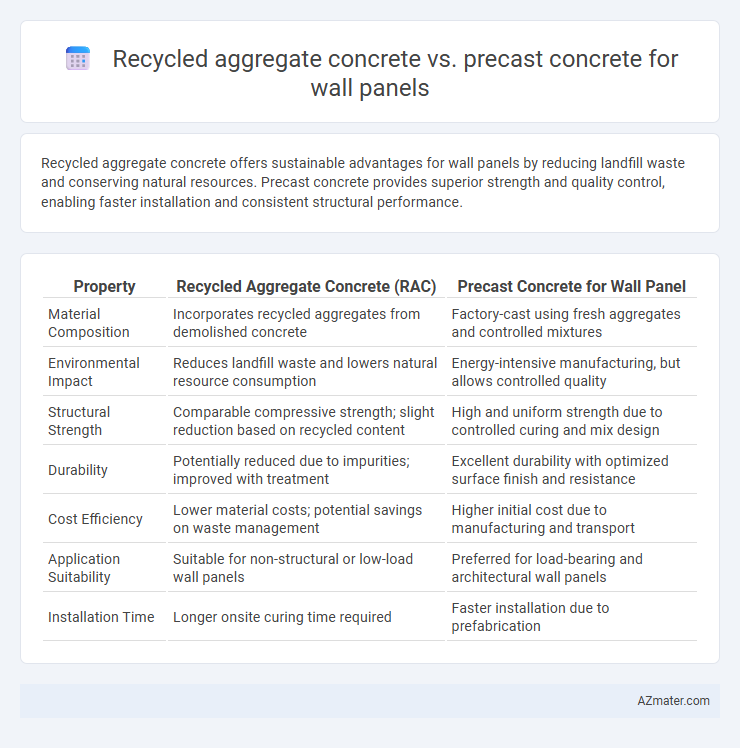Recycled aggregate concrete offers sustainable advantages for wall panels by reducing landfill waste and conserving natural resources. Precast concrete provides superior strength and quality control, enabling faster installation and consistent structural performance.
Table of Comparison
| Property | Recycled Aggregate Concrete (RAC) | Precast Concrete for Wall Panel |
|---|---|---|
| Material Composition | Incorporates recycled aggregates from demolished concrete | Factory-cast using fresh aggregates and controlled mixtures |
| Environmental Impact | Reduces landfill waste and lowers natural resource consumption | Energy-intensive manufacturing, but allows controlled quality |
| Structural Strength | Comparable compressive strength; slight reduction based on recycled content | High and uniform strength due to controlled curing and mix design |
| Durability | Potentially reduced due to impurities; improved with treatment | Excellent durability with optimized surface finish and resistance |
| Cost Efficiency | Lower material costs; potential savings on waste management | Higher initial cost due to manufacturing and transport |
| Application Suitability | Suitable for non-structural or low-load wall panels | Preferred for load-bearing and architectural wall panels |
| Installation Time | Longer onsite curing time required | Faster installation due to prefabrication |
Introduction to Sustainable Wall Panel Solutions
Recycled aggregate concrete utilizes crushed concrete and other recycled materials to reduce environmental impact and conserve natural resources in wall panel production. Precast concrete offers high durability and uniform quality with efficient factory-controlled processes, minimizing construction waste on-site. Both methods contribute to sustainable wall panel solutions by enhancing resource efficiency and enabling faster, eco-friendly building projects.
Overview of Recycled Aggregate Concrete
Recycled aggregate concrete (RAC) utilizes crushed concrete debris as aggregate, reducing the demand for natural resources and minimizing construction waste. This sustainable material offers comparable strength and durability to conventional concrete, making it suitable for wall panels in various building applications. The use of RAC enhances environmental performance by lowering carbon emissions and promoting circular economy practices within the construction industry.
Understanding Precast Concrete Technology
Precast concrete technology involves manufacturing wall panels in controlled factory environments, ensuring high precision, quality, and durability compared to traditional methods. Recycled aggregate concrete uses crushed waste concrete as aggregate, promoting eco-friendly construction but potentially affecting mechanical properties like strength and durability. Understanding the benefits of precast concrete technology highlights its superior dimensional accuracy, efficient construction time, and reduced on-site labor, making it favorable for producing consistent, high-performance wall panels.
Material Properties Comparison
Recycled aggregate concrete (RAC) for wall panels exhibits lower density and reduced compressive strength compared to traditional precast concrete due to the inclusion of recycled materials such as crushed concrete and masonry. Precast concrete offers superior durability, higher tensile strength, and better dimensional accuracy, resulting from controlled manufacturing conditions and the use of virgin aggregates. The porosity and water absorption rate are typically higher in RAC, impacting its thermal insulation and overall structural performance relative to precast elements.
Environmental Impact Assessment
Recycled aggregate concrete significantly reduces environmental impact by minimizing quarrying waste, lowering carbon emissions, and conserving natural resources compared to traditional precast concrete. Life cycle assessment shows that recycled aggregate concrete decreases embodied energy and landfill use, contributing to sustainable construction practices. However, precast concrete offers controlled manufacturing conditions that optimize material efficiency and energy use, which can mitigate some environmental drawbacks depending on production scale and transportation distances.
Structural Performance and Durability
Recycled aggregate concrete for wall panels offers enhanced sustainability by utilizing construction waste while maintaining competitive compressive strength and load-bearing capacity compared to traditional precast concrete. Precast concrete panels, produced under controlled factory conditions, typically exhibit superior durability with lower permeability, improved resistance to freeze-thaw cycles, and reduced risk of cracking. Structural performance of recycled aggregate concrete can be optimized through proper mix design and quality control, but precast concrete remains the benchmark for long-term durability and uniformity in wall panel applications.
Cost Analysis and Economic Considerations
Recycled aggregate concrete (RAC) for wall panels offers significant cost savings through reduced material expenses and waste management fees compared to traditional precast concrete. Precast concrete involves higher upfront costs due to factory fabrication, transportation, and formwork, but it provides quicker installation and long-term durability, potentially lowering maintenance costs. Economic considerations favor RAC in sustainability-driven projects with local material availability, while precast concrete suits budgets prioritizing consistent quality and construction speed.
Installation Process and Construction Time
Recycled aggregate concrete wall panels offer easier handling due to reduced weight, which can accelerate installation compared to traditional precast concrete panels. The installation process for recycled aggregate concrete panels often requires standard lifting and fixing techniques, similar to precast methods, but benefits from improved sustainability credentials. Construction time can be shortened with recycled aggregate concrete by reducing on-site curing periods, while precast concrete panels rely on factory manufacturing schedules but allow for rapid onsite assembly.
Design Flexibility and Architectural Applications
Recycled aggregate concrete offers enhanced design flexibility for wall panels by allowing customizable mix designs that incorporate various recycled materials, promoting sustainability while maintaining structural integrity. Precast concrete provides precise dimensional control and surface finishes, enabling intricate architectural details and fast installation but is less adaptable to on-site modifications. Both materials support diverse architectural applications, with recycled aggregate concrete favoring eco-friendly designs and precast concrete excelling in uniformity and repetitive panel production.
Future Trends and Innovations in Wall Panel Construction
Recycled aggregate concrete is gaining traction in wall panel construction due to increasing sustainability demands, offering enhanced environmental benefits by reducing construction waste and carbon footprint. Precast concrete panels continue evolving with embedded smart sensors and modular designs, improving structural performance and enabling faster, more efficient assembly. Future trends emphasize integrating recycled materials into precast systems, advancing automation and digital fabrication technologies to optimize resource use and enhance durability.

Infographic: Recycled aggregate concrete vs Precast concrete for Wall panel
 azmater.com
azmater.com